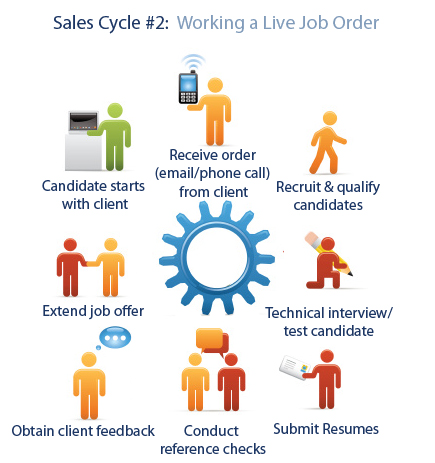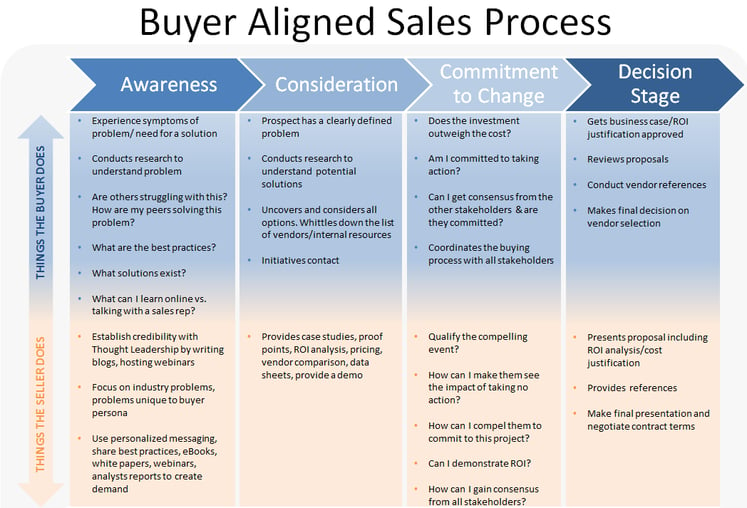Six Benefits to Adopting Mutual Action Plans
Mutal action plans, also known as customer success plan, joint execution plans or go-live plan, ensure the sales and delivery team is in alignment...

Operationalizing your sales team under a common sales process will help you win more deals. It will also help you win bigger deals faster and more frequently. Most staffing organizations make two fatal mistakes when it comes to creating a sales process.
First, most staffing organizations invest heavily in Applicant Tracking Systems (ATS) and/or Customer Relationship Management (CRM) software with the expectation that the software is the sales process. Your CRM or ATS software is NOT your sales process but a system to support the automation workflow of your sales process. This strategy and investment rarely translates into field adoption, resulting in unpredictable and unfavorable results.
Second, when designing sales process, most staffing organizations focus exclusively on the activities to be performed by the seller or the recruiter  and fail to account for what the buyer has to do in order to buy the service and hire the candidate.
and fail to account for what the buyer has to do in order to buy the service and hire the candidate.
In this blog post I'm going to share with you how creating a buyer aligned sales process improves sales effectiveness and creates value for the customer.
Look at the illustration to the right. Look familiar? This is how most in the staffing industry would describe or illustrate their sales process. What is missing in the diagram are all of the steps and activities that the buyer must complete and the decisions the buyer must make before the sale can close.
Part of improving sales effectiveness and maintaining a strong customer-focus and earning customer loyalty is being aware of the buyer’s journey and how it aligns with your sales process.
Once your sales reps are able to connect the two they can:
As your salespeople are progressing through the stages of the sales process, their prospects and customers are on their own path—the buyer’s journey. The buyer’s journey is the process buyers go through to become aware of, consider and evaluate, commit to and make a decision to purchase your or service. Top performing sales teams develop buyer personas, which can help an organization map out the buyer’s journey in detail.
Aligning Your Sales Process with the Buyer's JourneyUnderstanding where a prospect is in their buying process helps salespeople ask the right questions, share the most relevant information and focus on solving the most relevant problems, all of which moves the prospect to the next step of their buying process.
Creating and adopting a buyer aligned sales process allows your sales reps to quickly identify where a prospect is in the buyer’s journey, and meet them in the correct step of the selling process.
To align your sales process with the buyer’s journey, let’s define what activities or actions the prospect or client is taking during each stage of their journey.
Why a Buyer Aligned Sales Process is Worth the Investment
For staffing leaders looking to improve sales effectiveness, drive consistency, increase deal sizes, improve win rates and shorten your sales cycles, you'll want to consider adopting a buyer aligned sales process. When sales people take the time to put themselves in the shoes of the customer and "see things as the customers see them," sales reps gain a deep appreciation for how and why customers buy. Aligning your sales process with your buyer and how they buy will allow you to put the needs of your prospects front and center and make them the the focal point of your sales process rather than centering your sales process on your self-serving agenda and company pitch.
Instead of making a sales pitch for a meeting or pushing the customer for a job order, today's top performer focuses on guiding their buyer through their buying journey and purchasing process. They align their sales process including their messaging and content to the needs of the buyer as their progress through the buyer journey. A buyer aligned sales process is one that is designed to support the buyer and the seller to educate, consult and even challenge the buyer at each stage of the sales cycle. While this does require an upfront investment, it improves sales effectiveness and drives genuine buy-in from the sales force because it simply makes sense. It's how today's buyers buy which makes it the right way to sell. Who doesn't want to be viewed by their customer as a thought leader who is helpful and consultative? This process caters to and supports those sales behaviors.
Connecting Your Sales Process to the Buyer Journey
As mentioned previously, the buyer's journey refers to the specific steps and action items that your prospect or targeted audience must complete in order to buy your service. The first step to connecting your sales process to the buyer journey starts with plotting out the sequence of steps, activities or events the buyer is trying to complete as they evaluate their options and make their final decision. This normally starts with the buyer recognizing they have a problem (awareness stage) that needs to be resolved and the research that follows.
Next, below the buyer journey plot out the activities and steps the seller must complete to support the buyer in completing each step of their buyer journey. For example, if the prospect is in the awareness stage and experiencing symptoms of a data integration issue, the sellers activities should focus on providing the prospect with unbiased, third-party information such as a white paper or bench marking study to help the prospect diagnose their issue. The seller should NOT be pitching a candidate and pushing for a meeting.
This is your high level sales process. Review the illustration below to help guide you through the process of creating a buyer aligned sales process.

I think you will find as I have that redesigning the stages and objectives of your sales process will help you and your salespeople gain a greater appreciation of how and why customers buy and the process they go through.
Build Value into the Sales Process
After you map out your sales process, go back and examine each stage and think about what content, tools, resources and messaging would be most relevant and valuable for your buyer to receive and hear based on their stage of the buyer journey. For example, a buyer in the awareness stage probably doesn't want to hear your pitch on an available candidate nor do they want to sit down and meet with you to learn about your services since they can do that initial research online and are not yet considering potential solutions. What would be more relevant is the sales rep sharing information with the buyer to help them better understand their issue.
Repeat this process for each stage. When I went through this process I discovered that I had a lot of prospects in the awareness stage but I struggled to move my prospects down the funnel to the consideration and decision stage. What I discovered was I had created a lot of content for buyers in the awareness stage, but I had very little content designed for buyers in the consideration stage. Chances are you have content and messaging for prospects in the decision stage but not in the awareness or consideration stage. I've found that most staffing firms lack content and messaging for buyers in the awareness, consideration and commitment stage.
Finally, keep in mind that not all buyers follow the exact same buyer journey or purchasing process and purchasing habits and process change over time. This means your sales process will need to be agile. Designing your sales process is not a one time even but rather a living, breathing entity that evolves over time. The better you’re able to align your sales process with how your buyer's buy the more effective your sales reps will be. Fortunately, the investment to get there is well worth it.
If you want to improve sales performance, download the free eBook titled "The Definitive Guide to Building a Buyer Aligned Sales Process."

Mutal action plans, also known as customer success plan, joint execution plans or go-live plan, ensure the sales and delivery team is in alignment...

For the past few years, we've seen and heard the term "DevOps." You've likely seen them in the job descriptions you receive from your customers;...

Sales conversion ratios measure the effectiveness of your sales team at converting leads into new customers. It's an important metric to track for a...